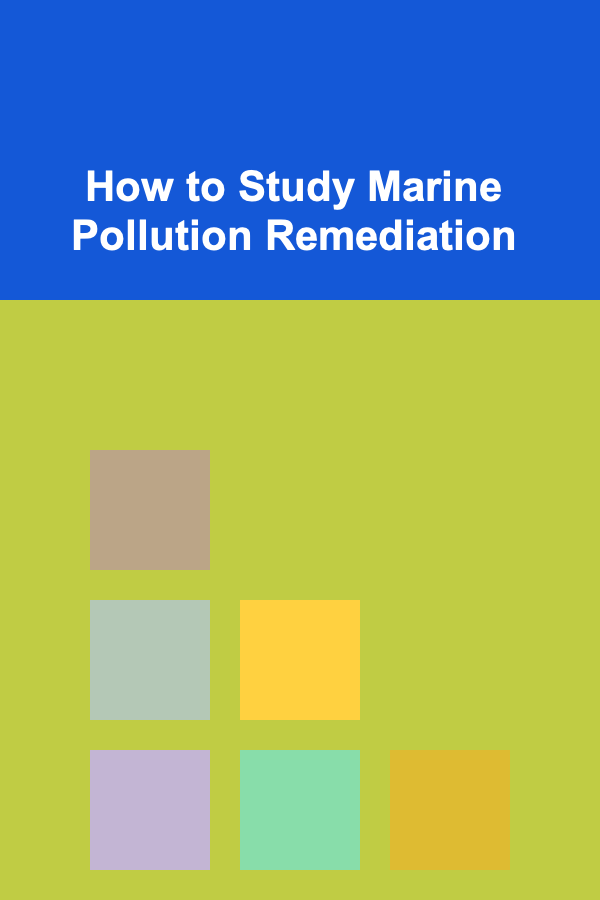
How to Study Marine Pollution Remediation
ebook include PDF & Audio bundle (Micro Guide)
$12.99$8.99
Limited Time Offer! Order within the next:

Marine pollution is one of the most critical environmental challenges of our time. Oceans, which cover over 70% of the Earth's surface, are essential for life on Earth, providing resources, regulating the climate, and supporting a vast array of biodiversity. However, these vital ecosystems are increasingly threatened by pollution, which has led to a growing need for effective pollution remediation strategies.
This article will explore the various aspects of marine pollution, focusing on how one can study and understand the process of marine pollution remediation. It will cover the types of marine pollution, the impacts on marine life and human health, the current technologies and methods used in remediation, and how to study the subject effectively.
Understanding Marine Pollution
Marine pollution occurs when harmful substances enter the ocean, affecting its ecosystems and the organisms that inhabit it. These pollutants can come from a variety of sources, including land-based activities, ships, offshore drilling operations, and atmospheric deposition. Marine pollution is categorized into several types, including:
1. Plastic Pollution
Plastic pollution has become one of the most pervasive and visible forms of marine pollution. Millions of tons of plastic waste enter the ocean every year, resulting in harmful effects on marine life. Marine animals, including fish, sea turtles, and birds, often mistake plastics for food, which can lead to ingestion and subsequent injury or death. Plastic pollution also disrupts marine ecosystems by affecting the food chain and blocking light from penetrating the water.
2. Chemical Pollution
Chemical pollutants, including pesticides, heavy metals, and petroleum products, are another significant source of marine pollution. These substances can be toxic to marine organisms, leading to bioaccumulation and biomagnification within the food web. For example, mercury and other heavy metals can enter the ocean through industrial runoff or atmospheric deposition and accumulate in marine species, affecting their health and, ultimately, human health when consumed.
3. Nutrient Pollution
Nutrient pollution, primarily from agricultural runoff, leads to the excessive growth of algae in the ocean. This phenomenon, known as eutrophication, can cause harmful algal blooms (HABs), which deplete oxygen levels in the water, creating "dead zones" where marine life cannot survive. Nutrient pollution is often caused by the overuse of fertilizers and improper waste disposal practices.
4. Oil Spills
Oil spills are catastrophic events that can cause extensive damage to marine environments. When large quantities of oil are released into the ocean, they coat the surface of the water, suffocating marine life and disrupting ecosystems. Oil spills also damage coastal habitats and pose long-term challenges for remediation efforts.
5. Marine Debris
Marine debris refers to human-made objects that enter the marine environment, such as fishing nets, ropes, and other materials. These objects can entangle marine animals, leading to injury or death, and also contribute to the general pollution of the ocean.
The Importance of Marine Pollution Remediation
The importance of marine pollution remediation cannot be overstated. Pollution in the oceans not only threatens marine biodiversity but also impacts global food security, tourism, and economic stability. Some of the key reasons why remediation is critical include:
- Protecting Marine Life: Marine organisms, from the smallest plankton to the largest whales, depend on a clean and healthy ocean to thrive. Pollution disrupts ecosystems, causing species to die off or relocate.
- Human Health: Pollutants such as heavy metals, chemicals, and plastics can enter the human food chain through seafood consumption. Marine pollution also affects water quality, which is essential for human health.
- Economic Impact: Many coastal economies rely on tourism, fishing, and other marine-related industries. Polluted oceans reduce fish stocks, degrade coastal habitats, and make areas less attractive to tourists.
- Climate Change: Healthy oceans act as a buffer against climate change by absorbing carbon dioxide. Polluted oceans cannot perform this function effectively, exacerbating the impacts of climate change.
Studying Marine Pollution Remediation
Studying marine pollution remediation involves understanding both the science behind the pollutants and the strategies used to remove or neutralize them. Below are the primary areas to focus on when studying this field.
1. Marine Pollution Assessment
The first step in any remediation process is assessing the type, extent, and severity of pollution in the marine environment. This involves:
- Monitoring Pollutants: The use of sensors, satellite imaging, and water sampling techniques to detect pollutants in the water. This includes measuring chemical levels, plastic concentrations, and other harmful substances.
- Mapping Pollution Hotspots: Identifying areas with the highest concentration of pollutants to target remediation efforts effectively.
- Impact Studies: Understanding the impact of pollutants on marine species, ecosystems, and human communities. This involves conducting field studies, laboratory experiments, and modeling to predict the long-term effects of pollution.
2. Remediation Techniques
Several techniques are used to remediate marine pollution, depending on the type and scale of pollution. These techniques fall into two broad categories: passive and active remediation methods.
Passive Remediation Methods
Passive remediation methods involve letting natural processes take their course with minimal human intervention. These methods rely on the natural ability of ecosystems to clean themselves.
- Biodegradation: The natural breakdown of organic pollutants by microorganisms. In the case of oil spills, certain bacteria can break down hydrocarbons, slowly reducing the pollution over time.
- Natural Recovery: Allowing ecosystems to recover naturally through the reduction of pollutants. For example, reducing nutrient pollution can help restore oxygen levels in "dead zones."
Active Remediation Methods
Active remediation techniques require human intervention to remove or neutralize pollutants more quickly and effectively.
- Bioremediation: This involves using living organisms, such as bacteria or algae, to degrade or absorb pollutants. For example, some bacteria can break down oil or plastics, while certain types of algae can absorb excess nutrients.
- Physical Removal: Methods such as skimming or dredging are used to physically remove pollutants from the water. For instance, oil skimmers are used to collect oil spills from the surface of the water.
- Chemical Treatment: Chemical agents can be used to neutralize or break down pollutants. For example, dispersants are used to break up oil slicks, while flocculants can help remove heavy metals from the water.
- Pollution Barriers and Booms: These devices are used to contain pollutants, such as oil, in a specific area, preventing them from spreading and facilitating easier cleanup.
3. Research and Innovation
Ongoing research plays a vital role in improving the efficiency and effectiveness of pollution remediation methods. Some key areas of research include:
- New Materials for Pollution Removal: Researchers are exploring new materials, such as biodegradable plastics, advanced filtration systems, and novel absorbents, to remove pollutants more efficiently.
- Genetic Engineering: Scientists are experimenting with genetically modified organisms (GMOs) that can degrade pollutants faster or more effectively than natural organisms.
- Nanotechnology: The use of nanomaterials, such as nanobots or nanoparticles, has shown promise in breaking down pollutants on a molecular level. These technologies may offer revolutionary solutions to marine pollution.
- Integrated Approaches: Combining multiple remediation techniques to maximize effectiveness. For example, combining bioremediation with physical removal methods may yield faster results.
4. Policy and Regulations
Effective remediation also depends on the creation and enforcement of policies and regulations aimed at reducing marine pollution in the first place. This includes:
- International Agreements: Treaties such as the MARPOL Convention (International Convention for the Prevention of Pollution from Ships) set global standards for pollution prevention in the marine environment.
- National Legislation: Governments implement laws to regulate industrial discharges, land-based pollution, and waste disposal practices. For example, regulations on the use of fertilizers and the treatment of wastewater can reduce nutrient pollution.
- Public Awareness Campaigns: Education and outreach programs are essential to reduce the public's contribution to marine pollution. This includes reducing plastic use, proper waste disposal, and advocating for sustainable fishing practices.
5. Career Opportunities in Marine Pollution Remediation
If you're interested in studying marine pollution remediation, there are numerous career paths in this field. These include:
- Marine Biologist: Studying the effects of pollution on marine life and ecosystems.
- Environmental Chemist: Conducting research on chemical pollutants and developing new methods of pollution removal.
- Environmental Engineer: Designing and implementing technologies for water purification and pollution remediation.
- Policy Analyst: Working with governments or NGOs to create and enforce policies to protect marine environments.
- Oceanographer: Studying the physical, chemical, and biological aspects of the ocean to better understand pollution dynamics.
Conclusion
Marine pollution is one of the greatest threats to ocean health, biodiversity, and human well-being. Studying marine pollution remediation requires an understanding of various pollutants, their impacts, and the techniques used to clean up polluted environments. The field is multidisciplinary, involving science, engineering, policy, and public education. As new technologies and approaches continue to emerge, the potential for more effective and sustainable solutions to marine pollution grows. By studying this critical field, we can take meaningful steps toward restoring and protecting our oceans for future generations.

How to Stage a Home with Pets: A Comprehensive Guide
Read More
How To Start a Craft Beer Podcast
Read More
How to Use DIY Projects to Decorate Your Home for Less
Read More
Mastering Financial Advisor Skills: Strategies and Tools for Success
Read MoreHow to Use a Retirement Account Tracker to Plan for Early Retirement
Read More
How to Develop a Political Campaign Budget That Works
Read MoreOther Products

How to Stage a Home with Pets: A Comprehensive Guide
Read More
How To Start a Craft Beer Podcast
Read More
How to Use DIY Projects to Decorate Your Home for Less
Read More
Mastering Financial Advisor Skills: Strategies and Tools for Success
Read MoreHow to Use a Retirement Account Tracker to Plan for Early Retirement
Read More